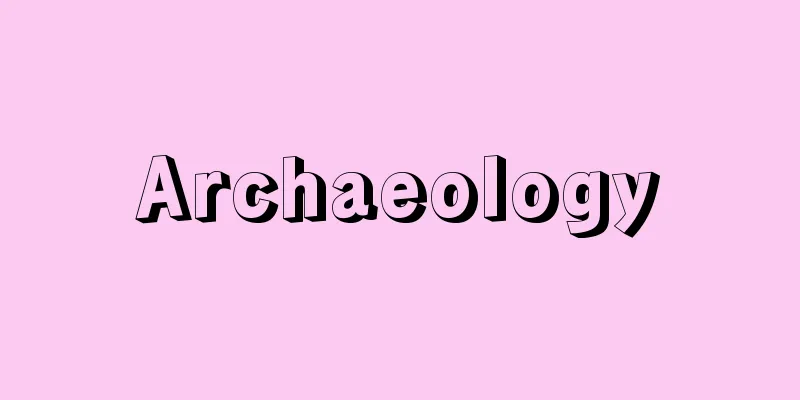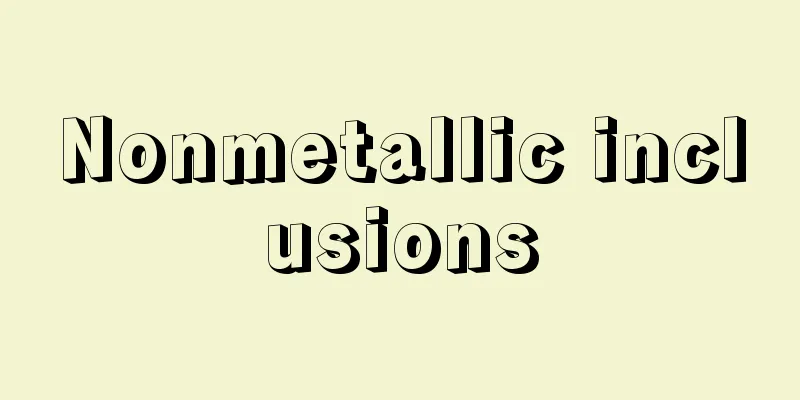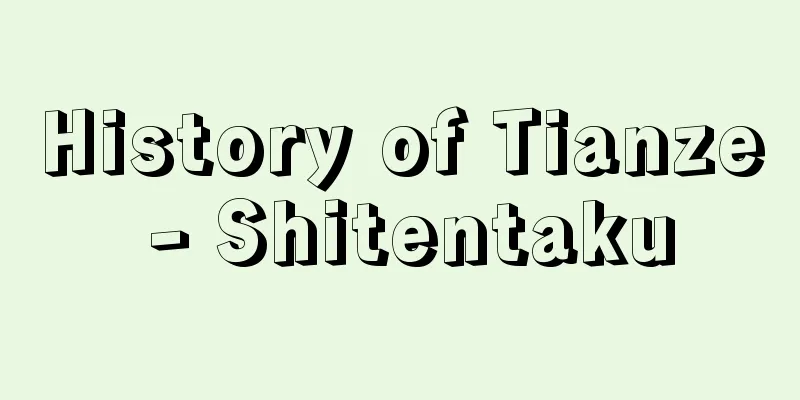Archaeology

|
The word "archaeology" has been used in China since the Song dynasty, but the name of the academic field "archaeology" was created in the middle of the Meiji period as a translation of the English word "archaeology," and Chinese academia followed suit. [Fumiei Tsunoda] The Concept and Nature of ArchaeologyThe European word for archaeology comes from the Ancient Greek arkhaiologia, a combination of arkhaios, meaning "ancient" or "first," and logos, meaning "science." As found in the works of Greek authors, including Plato, it meant "narratives about ancient times" or "history of ancient times." Currently, with the exception of American archaeologists and social anthropologists, the commonly adopted definition of archaeology is that "archaeology is the study of the human past through ruins and artifacts." This definition was proposed by British archaeologist DG Hogarth (1862-1927) in 1899 and adopted by Kosaku Hamada in Japan, but there is a strong trend of opposition to this definition in modern times. This is because, whether using artifacts and ruins as materials or documents, the only academic field that studies the human past is history, not archaeology. Behind this definition lies the 19th century idea that history is the study of history based on documents. When considering a definition that reflects the current state of research today, the most appropriate definition is to define archaeology as the study of ancient artifacts. Archaeology is a branch of historical materials, which is a part of history, and is a methodology that supports historical research through artifacts and ruins. Archaeology is a partner of historical materials, along with philology, which uses documents as materials. The reason why ancient artifacts are strongly promoted under the name of "archaeology" is because there are no contemporary documents from the ancient period, which spans two million years, or even if there are, they are limited in quantity. For this reason, ancient artifacts and ruins are very important in the study of history. Terms such as medieval archaeology and industrial archaeology are also seen, but these are actually medieval artifacts and industrial artifacts. Archaeology, or the study of ancient artifacts, is a branch of historical materials, so archaeology and history are not on the same level. Historiology is the science that studies history, while archaeology is the methodology that investigates and studies ancient artifacts and ruins and provides the results obtained from this to historiology. [Fumiei Tsunoda] History of ArchaeologyAttempts to explore ancient times through relics and ruins date back to the pre-Christian era. King Nabunaid (6th century BC) of the Neo-Babylonian Empire was deeply interested in Babylonian history, and excavating the Temple of Shamash and discovering the remains of an Akkadian temple is considered to be the beginning of archaeological research. In his Histories, the Greek historian Thucydides (late 5th century BC) attempted to prove that the indigenous people of Delos were Carians based on weapons and burial styles found in ancient tombs. However, these were a fad in the history of archaeology, and no further research was done. Meanwhile, in China, research on ancient bronze artifacts was active from the end of the 11th century to the 12th century, as can be seen in the Kokō Tu and Xuanhe Bogu Tu, but it did not develop into a modern academic field. In Europe, interest in antiquities had finally increased from the latter half of the 16th century, but research worthy of the name of archaeology had to wait until the German Winckelmann. Winckelmann studied ancient Greek and Roman art based on the artworks themselves, while the Danish Thomsen divided ancient history into three periods: the Stone Age, the Bronze Age, and the Iron Age, and in this way organized numerous relics, traced the development of culture, and became the founder of prehistoric research. The French Boucher de Perthes (1788-1868) also paved the way for research into the Paleolithic period. However, the most widespread and vigorous research was in archaeology, focusing on Greek and Roman art, and the German Ch. G. Heyne (1729-1812) resurrected and used the term arkhaiologia to describe this type of research. The 19th century was a period of great development for archaeology, with large-scale ruins such as Nineveh, Babylon, Pergamum, Priene, and Olympia being excavated one after another. Schliemann's discovery and excavation of the city of Troy marked the beginning of the investigation of preclassical culture in the Aegean Sea and Greece. It also became clear that so-called prehistoric culture and classical culture were not distinct, but that the former was gradually connected to the latter. It was also confirmed that the study of prehistoric culture had entered the realm of archaeology as prehistoric archaeology. In the first half of the 20th century, archaeological research was hindered by the two world wars, but it was renewed when research expanded to Egypt, Southwest Asia, India, China, the Korean Peninsula and Japan. Notable achievements include the investigation of cave paintings in Europe, the study of Paleolithic chronology by H. Breuil (1877-1961), the establishment of typological research methods by Montelius, and the theorization of archaeological hermeneutics by Robert. In Japan, scholars such as Hamada Kosaku played a central role in promoting research. Archaeological research in Imperial Russia was actively pursued, led by the Uvarovs, but was forced to stagnate for a time after the October Revolution. Large-scale surveys continued, with particularly noteworthy excavations at the site of the royal palace of Knossos by Evans, at Persepolis by E. Herzfeld (1879-1948), and at Mohenjo-daro by J. H. Marshall (1876-1958). The long-standing excavations at Pompeii and Herculaneum were also given a new face by A. Maiuri (1886-1963). Research also got back on track in emerging countries that gained independence or reformed their systems after World War I (Finland, Hungary, Czechoslovakia, Turkey, etc.). The excavation of the Yin Ruins on the outskirts of Anyang city, Henan province, China, did not produce the results expected because too much emphasis was placed on the discovery of oracle bone inscriptions, but Anderson's discovery of ancient cultures with painted pottery in the same Henan and Gansu provinces and his chronology of these cultures are also unforgettable. This, combined with the research of JS Passek (1903-1968) into the Tripolye culture of southern Russia, attracted the academic world's attention to the issue of painted pottery culture in ancient Eurasia. Archaeological research has made great strides in the last 40 years since the end of World War II, and important remains and ruins have been discovered and investigated one after another. Of particular note are the research into the oldest Paleolithic cultures in East Africa, and the origins of agriculture and animal husbandry in Mesopotamia and Syria. The former Soviet Union has abandoned stagnation and begun vigorous research across the country, and important discoveries and investigations are being carried out one after another in China, a treasure trove of ancient cultural artifacts. Excavations have become more intensive in every country, and active research is now being carried out in areas that have not been investigated much before, such as East Africa, Greenland, the Sahara Desert, the Karakum Desert, the Altai Mountains, Primorsky Krai, Thailand, and Burma (now Myanmar). As a result, the state of the ancient world has become clearer than ever before. In response to these trends, there have been remarkable developments in research and preservation methods. Japanese archaeology in particular is known for its precise excavation methods. Aerial photography, topographical surveys using aerial photography, and aerial photography using balloons have become commonplace. Dating has received powerful assistance from physics and chemistry, including the radiocarbon ( 14C ) method, and X-ray photography has also produced good results in elucidating inscriptions and patterns. The use of radio detectors to investigate underground conditions has become commonplace, and recently the use of fiberscopes to explore underground spaces has attracted attention. With the aid of these natural science methods, excavation surveys and indoor research of excavated artifacts have produced remarkable results, and in every country, a flood of research reports, collections of artifacts, catalogs, bibliographies, collections of essays, and magazines has emerged. Archaeologists are now overwhelmed by the sheer volume of documents, but at the same time, this has the negative effect of causing scholars to focus only on the trees and not see the forest. American archaeologists can be divided into two groups. The first group is made up of people who specialize in archaeology from various parts of the Old World (Egypt, Iraq, Syria, Israel, Greece, Italy, etc.), while the other group is mainly concerned with the research of pre-Columbian inhabitants of the New World. To distinguish the latter from the former, we call them Americanist archaeology, but they do not distinguish between general archaeology and Americanist archaeology, and simply call the latter "archaeology." Americanist archaeology was influenced by general archaeology (archaeology of the Old World) during its development, but after World War I it strengthened its ties with ethnology and social anthropology and followed its own path. For example, in North American universities, (Americanist) archaeology is considered a subject in the anthropology department along with physical anthropology and cultural anthropology (ethnology and social anthropology). Its mission is to study the pre-Columbian inhabitants of the New World - not the history of the inhabitants - through their remains and ruins. In other words, Americanist archaeology is a branch of cultural anthropology, and is similar but not the same as general archaeology, which is half of the historical science of history. Even if we accept the existence of such a discipline, it is questionable why it is called archaeology. Especially since the 1960s, New Archaeology (New Americanist Archaeology) was proposed, and the gap between Americanist archaeology and general archaeology as a branch of historical science was amplified. The fundamental difference in their positions is that one regards it as the study of historical documents within history, while the other recognizes it as a branch of anthropology. [Fumiei Tsunoda] Branches of ArchaeologyArchaeology is divided into various branches depending on the field of study. In the past, the three branches of prehistoric archaeology, protohistoric archaeology, and historical archaeology were popular, but this has been criticized in many ways and is rarely seen in Europe and the United States these days. In the current academic world in Europe, there is a tendency to divide archaeology into two branches: preclassical archaeology and classical archaeology. Some scholars also advocate a three-branch branch of archaeology: Stone Age archaeology, Bronze Age archaeology, and Iron Age archaeology, following the division of the three eras. However, the most common are regionally based divisions such as Japanese archaeology, Scandinavian archaeology, and Siberian archaeology. Greek archaeology is a division that covers not the present-day Hellenic Republic but the broader ancient Greek world. Art archaeology was also proposed early on, and there are also divisions based on religion, such as Buddhist archaeology, Shinto archaeology, Biblical archaeology, and Christian archaeology. More recently, divisions such as experimental archaeology and environmental archaeology have also been established. Archaeological research requires cooperation with various disciplines, and in some cases archaeology plays a part in interdisciplinary research on a single theme. In terms of collaboration, archaeology is most closely related to geology, petrology, paleoanthropology, paleontology, geography, architecture, statistics, and philology. In recent years, archaeology has been closely related to physics, chemistry, metallurgy, and other disciplines in relation to dating, preservation, and restoration of artifacts and ruins. Furthermore, research fields such as numismatics, epigraphy, symbolism, sigilology, and iconography partially overlap with those of archaeology, and each of these is inseparably linked to archaeology. [Fumiei Tsunoda] Archaeological Research MethodsArchaeological research begins with the investigation of artifacts and ruins. Some artifacts have been passed down (such as the treasures of Shosoin) and some are scattered above ground. Some ruins are exposed above ground as ruins (such as the Parthenon, the Five-Story Pagoda of Horyuji Temple, and the Thousand Buddha Caves at Dunhuang). However, many artifacts and ruins remain underground or even underwater as buried cultural properties. Therefore, investigations are often carried out outdoors. Archaeological investigations in the outdoors are sometimes called field archaeology or field archaeology (the Chinese name). Field investigations include reconnaissance surveys to discover ruins in a certain area, create a distribution map, and investigate the general characteristics of the ruins, field investigations to clean and measure the ruins, and excavations to dig up and investigate individual ruins. The excavation method varies depending on whether the site is a dwelling, settlement, temple or shrine, kiln, fortress, tomb, or a complex urban site. In all cases, excavation should be carried out step by step, with measurements and photographs constantly taken, and records kept of the location of artifacts and the condition of the layers. Attention should be paid to changes in soil color and quality, and stratigraphy and the incisions of overlapping building remains should be clearly identified. Footprints and wheel tracks of humans and cattle should not be overlooked. Excavation leads to the destruction of ruins in a sense, and ruins once excavated can never be restored to their original state. For this reason, excavation should be carried out with great care. Archaeological research has made remarkable progress in recent years, and excavation techniques have become extremely sophisticated, so excavators must use the latest excavation techniques to proceed carefully and without rushing. Furthermore, soil found at ruins, particularly shell mounds, remains of dwellings, and inside burial mounds, is not simply discarded but is kept in whole or in part for analysis, with particular care being taken with pollen and volcanic ash that cannot be seen with the naked eye. The soil must be thoroughly washed with water, and not only minute artifacts but also plant seeds and small fish bones must be extracted. Backfilling after excavation must also be carried out carefully, with due consideration given to the preservation of the ruins and future reinvestigations. The remains obtained from surveys and excavations must first be organized. This is called indoor work, and the work proceeds in the following order: washing, cleaning, joining, repairing, restoring, classifying, making traces, measuring, photographing, and describing. The measured drawings of the ruins and remains are traced to an appropriate scale. The next step is the real research stage, but the first step is to determine the age of the artifacts and ruins. In archaeology, there is a distinction between relative and absolute dating. Relative dating, which says that B is newer than A and older than C, is obtained by using stratigraphic knowledge obtained during excavation (stratigraphy) and comparison of the forms of each artifact (morphology), either alone or in combination. Absolute dating is a date that is fixed in time and does not change. It is obtained by physicochemical measurements using radiocarbon ( 14C ), fluorine, magnetism, etc., tree ring examinations (tree-ring dating), documentary evidence, etc. For example, the tomb of Oharida no Ason Yasumaro is understood to have been built in the 6th year of the Jinki era (729) based on the copper plate epitaph that was excavated. After repeating these various dating methods, the age of a certain ruin or group of artifacts, or the age of a certain combination of artifacts, is known. In many cases, the approximate age can be determined from documents, volcanic ash, and other sources. After dating, the next step is the interpretation of the artifact or site. Archaeological hermeneutics has been developed for Greek pottery paintings or Roman sarcophagus inscriptions, and involves making full use of other knowledge, such as historical knowledge, mythology, ethnology, iconography, geography, and biology, in conjunction with the artifact or site. In other words, it provides a satisfactory explanation for questions such as what it was, how it was made, what it was used for, why it was made, what it means, what it represents, who made it, who was the school that made it, and so on. For example, who created the Venus de Milo? What movement were the missing arms in? What is the purpose of the entasis seen on the columns of Greek temples? What do the murals on the Takamatsuzuka Tomb represent? Is the 18-foot-tall gilt bronze Buddha that is the principal image of Kanimanji Temple a statue of Shaka Nyorai or Yakushi Nyorai? What was the cause of the scratches on a stone tool captured under a microscope? There are countless questions such as these, and hermeneutics answers them by clarifying the basis of its argument. After completing this stage, archaeologists prepare a report on the investigation and take steps to restore and conserve the site and preserve the artifacts. Good examples of restoration of archaeological sites are found in the Abbondanza district of Pompeii and the palace of King Minos on Crete. Regarding the preservation of artifacts, special attention is given to organic (e.g. wooden) and iron artifacts. The final step in the archaeological research process is synthesis. Here, all knowledge gained up to that point is synthesised, a "culture" is defined within a certain period and region, the living environment of the people who carried that culture and the content of each culture are investigated in as much detail as possible, and the progression of cultures, contacts and connections with other cultures, and relationships with ethnic groups or tribes that are known from documents are pursued. Furthermore, in areas where research and investigation has been insufficient, it may be necessary to divide the cultural sequence that has been identified into three periods: the Stone Age, the Bronze Age, and the Iron Age (the three-period method) and establish a period division into the history of technology. [Fumiei Tsunoda] History and ArchaeologyArchaeologists are essentially historians. Similarly, philologists are also historians. Historians appropriately evaluate and adopt the research results provided by archaeologists and philologists, and write (reconstruct) history. In doing so, historians must not mechanically splice together the research results of two fields of historical study. This requires a high level of criticism. Furthermore, when archaeological and philological research results contradict each other on the same subject, it is essential not to combine the two indiscriminately. [Fumiei Tsunoda] Current IssuesArchaeological research is gradually shedding light on two million years of human history. Amazing discoveries of ancient artifacts and ruins through excavations are making headlines in newspapers every day in countries around the world. Archaeologists are busy with excavations every day, but they are also dazzled by the vast amount of information they receive, and they fall into the trap of focusing on the nitty-gritty of the science and neglecting research into methodology. As a result, many difficult problems related to archaeological methodology remain unresolved, and despite the many new discoveries, this prevents an appropriate systematization of ancient history. Archaeologists are called upon to stop getting excited about discoveries of new ruins and artifacts, and to calmly reflect on methodological considerations. [Fumiei Tsunoda] "General Theory of Archaeology" by Hamada Kosaku (1959, Yuzankaku Publishing)" ▽ "Expanded edition of "An Introduction to Ancient Studies" by Tsunoda Fumiei (1972, Yamakawa Publishing)" ▽ "Archaeology Seminar" edited by Serizawa Chosuke, Otsuka Hatsushige, and Mori Koichi (1976, Yamakawa Publishing)" ▽ "Silent World History 5: Culture of Stone and Forest" by Tsunoda Fumiei (1971, Shinchosha)" ▽ "History of Japanese Archaeology" by Saito Tadashi (1974, Yoshikawa Kobunkan)" ▽ "History of American Archaeology" by Willie Sabloff, translated by Kotani Yoshinobu (1979, Gakuseisha)" ▽ "Dictionary of the History of Japanese Archaeology" by Saito Tadashi (1984, Tokyodo Publishing)" [Reference] |Ruins of the ancient Babylonian city. The photo shows part of the double gate of the Ishtar Gate. Southern suburb of Baghdad, Iraq ©Shogakukan "> Ruins of Babylon The open-air theater on the Acropolis of Pergamon Hill. Bergama, Turkey ©Shogakukan "> Ruins of Pergamum The remains of a martial arts arena called "Palestra". The courtyard used for training was surrounded by a colonnade, and was equipped with bathrooms and changing rooms. Part of the World Heritage Site "Ancient Ruins of Olympia" (Greece, registered in 1989) Greece Peloponnese ©Shogakukan "> Olympia Ruins "Martial Arts Arena" The ruins of the palace believed to be the residence of the legendary King Minos. Construction began around 2000 BC, but it collapsed around 1700 BC and was immediately rebuilt. Most of the existing remains are from this new palace. The photo shows the colonnade at the north entrance to the palace. Near Heraklion, Greece ©Shogakukan "> Knossos Palace Ruins The area with the rows of columns at the rear is the Audience Hall. In front of it (left in the photo) is the Hall of a Hundred Columns, with many remaining columns. World Heritage Site "Persepolis" (Iran, registered in 1979) Iran, northeast of Shiraz ©Shogakukan "> Ruins of Persepolis The fortified area. In the center is a bathing area with a 12 x 7m water tank. To the east and west of it are large granaries and spacious buildings, making this the most important part of the city. The stupa in the back was built later. World Heritage Site "Mohenjo-Daro Ruins" (Pakistan, registered in 1980) Pakistan Lal Khana ©Shogakukan "> The ruins of Mohenjo Daro The ruins of a city discovered in the mid-16th century. It is a valuable ruin that tells us about urban life in ancient Rome, and the appearance of the city just before it was buried under volcanic ash has been preserved exactly as it was. Part of the World Heritage Site "Archaeological Areas of Pompeii, Herculaneum and Torre Annunziata" (registered in Italy in 1997) Near Naples, Italy ©Shogakukan "> Ruins of Pompeii An ancient city buried by the eruption of Mount Vesuvius in 79 AD. At the time, it prospered as a villa area for Roman citizens, and public buildings and elegant mansions were built there. Part of the World Heritage Site "Archaeological Areas of Pompeii, Herculaneum and Torre Annunziata" (Italy, registered in 1997) Italy Herculaneum ©Shogakukan "> Ruins of Herculaneum (Herculaneum) A temple built in the center of the Athenian Acropolis. Designed by the ancient Greek architect Ictinos, it was completed around 438 BC. It is about 30m wide and 70m deep, and has 46 Doric marble columns. Part of the World Heritage Site "Acropolis of Athens" (Greece, registered in 1987) Greece Athens ©Shogakukan "> Parthenon Source: Shogakukan Encyclopedia Nipponica About Encyclopedia Nipponica Information | Legend |
|
「考古」という語は、中国では宋(そう)代から用いられているが、「考古学」という学問の名は、明治時代の中ごろ、英語のarchaeologyの訳語としてつくられ、中国の学界もまたこれに倣ったものである。 [角田文衛] 考古学の概念と本質ヨーロッパ諸語の考古学を示す語は、古代ギリシア語のarkhaiologiaに由来するが、これは、「古代の」「最初の」を意味するarkhaiosと「学」を示すlogosとの結合した語である。プラトンをはじめとしてギリシアの著述家の作品に見受けられる限りでは、それは「古代についての物語」または「古代の歴史」の意味であった。 現在、アメリカの考古学者や社会人類学者を例外として、一般に採用されているのは、「考古学は、遺跡・遺物によって人間の過去を研究する学である」という定義である。これは、1899年イギリスのホガースD. G. Hogarth(1862―1927)が提案し、日本では浜田耕作が採用した定義であるが、現代ではこれに反対する風潮も強い。なぜならば、遺物・遺跡を資料にしようと、文献を用いようと、人間の過去を研究する学問は歴史学だけであって、考古学ではないからである。この定義の背景には、歴史学は文献に基づいて歴史を研究するといった19世紀的な考え方が伏在しているのである。 今日、研究の実情に即した定義を思索してみると、もっとも適切なのは、考古学を古代遺物学と規定することである。遺物学は、歴史学の一部門をなす史料学の一分科であって、遺物・遺跡を通じて歴史学の研究を補助する方法学である。考古学は、文献を資料とする文献学とともに史料学の双手をなしている。古代に関する遺物学が「考古学」の名で強く前面に押し出されているのは、200万年にもわたる古代には同時代的文献がまったくないか、あっても数量的に限られているからである。それだけに、歴史を研究するうえで古代の遺物・遺跡のもつ比重は大きい。中世考古学、産業考古学といった用語もみられるが、それらは正しくは中世遺物学、産業遺物学のことなのである。考古学すなわち古代遺物学は、史料学の一分科なのであるから、考古学と歴史学とは同一平面上で相対するものではない。歴史学は歴史を研究する本質学であり、考古学は古代の遺物・遺跡を調査・研究し、それによって得られた成果を歴史学に提供する方法学なのである。 [角田文衛] 考古学の歴史遺物・遺跡を通じて古代を探究しようとする試みは、紀元前にさかのぼっている。すなわち、新バビロニア帝国のナブナイド王(前6世紀)は、バビロニアの歴史に関心が深く、シャマシュ神殿を発掘しアッカド時代の神殿跡を発見したのは、考古学的研究の嚆矢(こうし)とされる。またギリシアの歴史家トゥキディデス(前5世紀後半)は、その『歴史』のなかで、古墓から発見された武器やその埋葬様式のうえから、デロス島の先住民がカリア人であったことを証明しようと試みている。しかしこれらは考古学史上の狂い咲きであって、あとが続かなかった。一方、中国でも古銅器の研究は、『考古図』や『宣和博古図』にみられるとおり、11世紀末葉から12世紀にかけて盛んに行われたけれども、そのまま近代的な学術に成長することはなかった。 ヨーロッパでは古物に対する関心は16世紀後半からようやく高まってはいたが、考古学の名に値する研究は、ドイツのウィンケルマンを待たねばならなかった。ウィンケルマンは、作品自体に基づいてギリシア・ローマの古美術を研究したが、デンマークのトムセンは、遠古の歴史を石器時代、青銅器時代、鉄器時代に三分し、これによってあまたの遺物を整理し、文化の発展を跡づけ、先史研究の開祖となった。またフランスのブーシェ・ドゥ・ペルトBouch de Perthes(1788―1868)は、旧石器時代研究の道を開いた。しかしもっとも広範かつ旺盛(おうせい)に研究が進められていたのは、ギリシア・ローマの美術品を中心とした考古学であって、この種の研究に対してドイツのハイネCh. G. Heyne(1729―1812)は、考古学arkhaiologiaということばを復興・使用したのであった。 19世紀は、考古学にとって大発展の時期であって、ニネベ、バビロン、ペルガモン、プリエネ、オリンピアなどの大規模な遺跡が続々と発掘調査されたし、シュリーマンによるトロヤの城市の発見・発掘は、エーゲ海、ギリシア方面における前古典文化を究明する端緒をなし、いわゆる先史文化と古典文化が異質のものではなく、前者は段階的に後者に連結することも明らかとなり、先史研究は、先史考古学として考古学の領域に入ることも確認された。 20世紀の前半には、二つの世界大戦があって、考古学の研究調査も阻害されたが、調査の手はエジプト、西南アジア、インド、中国、朝鮮半島や日本にも伸び、面目は一新された。ヨーロッパにおける洞窟(どうくつ)壁画の調査、ブルイユH. Breuil(1877―1961)による旧石器時代編年の研究、モンテリウスによる型式学的研究法の確立、ローベルトによる考古解釈学の理論化などは注目される。日本では、浜田耕作らの学者が中心となって研究調査を推進した。帝政ロシアにおける考古学的研究調査は、ウバーロフ夫妻を推進者として活発に進められていたが、十月革命以後はしばらく停滞を余儀なくされていた。 大規模な調査は依然として続行されたが、とくにエバンスによるクノッソス王宮址(し)、ヘルツフェルトE. Herzfeld(1879―1948)によるペルセポリス、マーシャルJ. H. Marshall(1876―1958)によるモヘンジョ・ダーロの発掘調査などは特筆される。古くから続けられているポンペイやヘルクラネウムの発掘も、マイウーリA. Maiuri(1886―1963)によって面目を一新した。第一次世界大戦後に独立または体制を改めた新興国(フィンランド、ハンガリー、チェコスロバキア、トルコなど)においても、研究調査は軌道に乗った。中国河南(かなん/ホーナン)省安陽(あんよう/アンヤン)市郊外にある殷墟(いんきょ)の発掘は、甲骨文字の発見などに重点が置かれすぎたため、予期されたほどの成果をあげなかったが、同じ河南省や甘粛(かんしゅく/カンスー)省でアンダーソンが彩陶を伴う遠古の諸文化を発見し、これを編年した功績も忘れがたい。それは、パセックJ. S. Passek(1903―1968)による南ロシアのトリポリエ文化の研究と相まって、古代ユーラシアの彩文陶器文化の問題に学界の関心をひいたのであった。 第二次世界大戦後から今日に至る40年間に考古学の研究調査は大躍進を遂げ、これに並行して重要な遺物・遺跡が次々と発見・調査された。なかでも特記されるのは、東アフリカにおける最古の旧石器諸文化の研究、メソポタミア、シリア方面における農耕・牧畜の起源の研究などである。旧ソ連は停滞性をかなぐり捨て、全土にわたって猛烈な調査を始めたし、古文物の宝庫である中国においても、重要な発見、調査は続々と行われている。どの国においても発掘調査の密度が濃くなったが、これまで調査が手薄であった諸地域――東アフリカはむろんのこと、グリーンランド、サハラ砂漠、カラクム砂漠、アルタイ山地、沿海州、タイ、ビルマ(現、ミャンマー)など――でも活発な研究調査がみられるに至った。これらによって古代世界の様相は、以前とは比べものにならぬほど判然としてきた。 これらに即応して調査法、保存法にも目覚ましい進展がみられた。とくに日本の考古学界は、精密な発掘法で知られている。航空写真、これを用いた地形測量、風船による俯瞰(ふかん)写真などは日常茶飯事となった。年代決定には、放射性炭素(14C)法をはじめとして物理学や化学の面から強力な援助を被ったし、X線写真による銘辞や文様の解明も、好成績をあげている。電波探知機による地下の状態の探査などは普通のこととなったが、最近ではファイバースコープによる地下空間の探究が注意をよんでいる。 そうした自然科学的諸方法の援助を得て、発掘調査や出土遺物の屋内での研究は著しい成果をもたらし、どの国においても、調査報告、遺物の集成や図録、文献目録、論集、雑誌の類が怒濤(どとう)のように氾濫(はんらん)し、いまや考古学者たちは、これら膨大な文献との応接に追われて困憊(こんぱい)しているし、他方では学問をするうえで木を見て森を見ない弊害も生じている。 アメリカの考古学者たちは、2群に分けられる。第一は、旧大陸各地(エジプト、イラク、シリア、イスラエル、ギリシア、イタリアなど)の考古学を専攻する人々であり、他は、主として先コロンブス時代の新大陸の住民を研究対象とするグループであって、後者は前者と区別するため、アメリカニスト考古学とよんでおくが、彼らは一般の考古学とアメリカニスト考古学を区別せず、後者をも単に「考古学」とよんでいる。 アメリカニスト考古学は、発展途上で一般考古学(旧大陸の考古学)の影響を被りはしたが、第一次大戦以後は民族学や社会人類学との連携を強め、独自の路線をたどるに至った。たとえば、北アメリカの大学教育では、(アメリカニスト)考古学は、自然人類学、文化人類学(民族学、社会人類学)とともに人類学科の1科目とされている。その任務は、新大陸における先コロンブス時代の住民――住民の歴史ではない――を遺物・遺跡を通じて研究するにある。つまりアメリカニスト考古学は、文化人類学の一部門であって、歴史学における史料学の一半をなす一般考古学とは似て非なるものである。こうした学問の存在を許容したとしても、なぜそれを考古学とよぶのかが疑問とされる。とくに1960年代以後はニュー・アーケオロジー(新アメリカニスト考古学)が提唱され、史料学の一部門としての一般考古学との乖離(かいり)は増幅された。根本的な立場の相違は、一が歴史学の史料学とみなすのに対して、他はこれを人類学の一部門と認めることにあるのである。 [角田文衛] 考古学の分科考古学には、その研究分野の別によって、さまざまな分科が設けられている。かつては先史考古学、原史考古学、歴史考古学の3分科が流行したが、これにはいろいろと批判があり、欧米では最近あまり見受けられなくなっている。現在のヨーロッパ学界では、前古典考古学と古典考古学との二つに考古学を分ける傾向がある。また三時代法の区分に従って、石器時代学、青銅器時代学、鉄器時代学の3分科を提唱する学者もいる。 しかしもっとも一般的なのは、地域に基づく分科であって、日本考古学、スカンジナビア考古学、シベリア考古学などがそれである。ギリシア考古学は、今日のギリシア共和国ではなく、それよりもっと広い、古代のギリシア世界を領域として設定された分科である。また早くから美術考古学が提唱されているし、さらに仏教考古学、神道(しんとう)考古学、聖書考古学、キリスト教考古学のような宗教に基づく分科も存する。最近では、実験考古学や環境考古学といった分科も設定されている。 考古学の研究には、種々な学問との協力が不可欠であるし、一つのテーマに対する学際的研究の一端を考古学が担う場合もある。協力関係では、とくに地質学、岩石学、古人類学、古生物学、地理学、建築学、統計学、文献学などは、もっとも縁の深い学問である。最近では、年代決定や遺物・遺跡の保存、復原などに関連して、物理学、化学、金属学その他との連係が強くなっている。また古銭学、銘辞学(金石学)、象徴学、印章学、図像学などの研究分野は、考古学のそれと部分的に重複しており、それぞれが考古学と不可分の関係をもっている。 [角田文衛] 考古学の研究法考古学の研究は、遺物・遺跡の調査から始まる。遺物には、伝世したもの(正倉院の宝物のような)、地上に散布しているものも存する。遺跡には、遺構として地上に露呈しているものもある(パルテノン、法隆寺五重塔、敦煌(とんこう/トゥンホワン)の千仏洞などのような)。しかし遺物・遺跡の多くは、埋蔵文化財として、地下まれには水中に遺存している。したがって調査は、野外で行われることが多い。野外における考古学的調査は、野外考古学、田野考古学(中国での名称)とよばれることがある。野外調査には、ある地域の諸遺跡を発見し、分布図をつくったり、遺跡のだいたいの性格を調べたりする踏査、遺構を清掃し実測する臨地調査、個々の遺跡を掘って調べる発掘などの別がある。 発掘の方法は、住居跡、集落跡、社寺の遺跡、窯跡、城塞(じょうさい)跡、墳墓、それらを複合した都市遺跡などによっていくらか相違するが、いずれの場合でも、順序を追ってすこしずつ掘り進め、絶えず実測や撮影を試み、遺物の出土位置や層の状態についての記録をとりながら実施する必要がある。土色、土質の変化には留意し、層序や、相重なる建物跡の切り込みなどを鋭く識別せねばならない。人間やウシなどの足跡、轍(わだち)の跡なども看過してはならない。発掘は、ある意味では遺跡の破壊につながり、一度掘った遺跡は二度と原状には復しない。そのため、発掘は努めて慎重に進める必要がある。近年、考古学の研究は著しく進歩し、それにつれて発掘技術もきわめて精巧となっているから、発掘担当者は、最新の発掘技術を駆使しながら注意深く、急がずに発掘を進めねばならない。なお、遺跡、とくに貝塚、住居跡、古墳内部などにあった土壌はそのまま捨てず、分析のため全部または一部分を保管するが、とくに肉眼では識別されずに混入している花粉や火山灰などには注意を要する。土壌はていねいに水洗いし、微細な遺物はもちろんのこと、植物の種子や魚類の小骨を採取する必要がある。発掘後の埋め戻しも、その遺跡の保存や将来における再調査をよく考慮し、慎重に実施せねばならない。 踏査や発掘で得られた遺物は、まず整理されねばならない。これを屋内作業といい、水洗い、清掃、接合、修理、復原、分類、取拓、実測、撮影、記述といった順序で作業が進められる。遺跡や遺物の実測図は、適当なスケールのもとにトレースされる。 ついで真の研究段階となるが、まず必要なのは、遺物・遺跡の年代の決定である。考古学上の年代には、相対年代と絶対年代との区別がある。BはAより新しく、Cより古いとする相対年代は、発掘の際に得られた層位的知見(層位学)と、各遺物のもつ形式の比較(形式学)を単独に行うか併用するかして得られる。絶対年代とは、年代的に定位され、動かない年代である。これは、放射性炭素(14C)、フッ素、磁気などによる物理化学的測定、年輪の検査(年輪年代法)、文献的証左などによって得られる。たとえば、小治田朝臣安万侶(おはりだのあそんやすまろ)の墓は、出土した銅板の墓誌によって神亀(じんき)6年(729)に営まれたことが理解される。こうした、さまざまな年代決定法を繰り返したのち、ある遺跡ないし遺物群の年代、またはある遺物の組合せの年代が知られる。また文献、火山灰その他から概定年代が知られる場合も少なくないのである。 年代決定の次は、遺物・遺跡の解釈である。考古解釈学は、ギリシアの陶画やローマの石棺の刻画などを対象として練磨されたものであって、遺物・遺跡に即しながら他のあらゆる知識――たとえば、歴史上の知見、神話学、民族学、図像学、または地理学や生物学などによる知識――を全幅的に活用して行うのである。すなわち、それは何であったか、どのようにして製作されたのか、何に使用されたのか、何のためにそうつくられたのか、何を意味しているか、何を表しているのか、製作者や流派の名は何か、といった数々の設問に対して、納得のゆくような説明を与えるのである。たとえば、ミロのビーナス像の製作者はだれか、欠損している両腕はいかなる動勢をとっていたのか、ギリシア神殿の円柱にみられるエンタシスは何のためなのか、高松塚古墳の壁画は何を表しているのか、蟹満(かにまん)寺の本尊の丈六の金銅仏は釈迦如来(しゃかにょらい)像か薬師如来像か、顕微鏡でとらえられたある石器の擦痕(さっこん)は何によってできたものか、などのように、無慮無数の設問があるわけであって、解釈学は論拠を明確にしながらそれらに答えていくのである。 考古学者は、この段階が済んだところで調査報告を作成し、また遺跡の復原と保存、遺物の保存の途を講ずる。遺跡の復原の好例は、ポンペイのアボンダンツァ街やクレタ島のミノス王の宮殿にみられる。遺物の保存に関しては、有機質(たとえば木製)の遺物や鉄製の遺物などがとくに配慮される。 考古学の研究過程の最後は総合である。ここでは、これまで得られたあらゆる知見を総合し、ある年代的範囲と地域を限って「文化」を設定し、その文化を担った人々の生活環境や各文化の内容をできるだけ詳しく究明し、また諸文化の推移、他との接触や関連、文献的に判明しているある民族ないし部族との関係が追究されるのである。 なお、研究調査が不十分な地域においては、いちおう明らかにされた文化系列を石器時代、青銅器時代、鉄器時代に三分し(三時代法)、とりあえず技術史時代区分を樹立することも必要であろう。 [角田文衛] 歴史学と考古学考古学者は本質的に歴史学者である。同様に文献学者も同様に歴史学者である。歴史学者は、考古学者や文献学者から提供された研究成果を適宜に評価・採用し、歴史を叙述(再構成)するのである。その際、歴史学者は、二つの史料学の研究成果を機械的に継ぎ合わせてはならない。そこには高度の批判が要請される。また同一の事柄に関して、考古学の研究成果と文献学のそれとが矛盾するような場合には、両者をみだりに結合せぬことが肝要である。 [角田文衛] 現在の課題考古学の研究調査によって、200万年に及ぶ人間の歴史は、しだいに判明しつつある。また世界各国において、発掘調査による驚嘆すべき古代の遺物・遺跡の発見は、日々の新聞紙上をにぎわしている。考古学者は、日々発掘調査に追いまくられる一方、膨大な発掘情報に眩惑(げんわく)され、学の末節にこだわり、方法論の研究をないがしろにする弊害に陥っている。そのため考古学の方法論に関するさまざまな難問題はいっこうに解決されず、新発見の数々にもかかわらず、それは古代史の適切な体系化を妨げている。考古学者は、新奇な遺跡・遺物の発見に雀躍(じゃくやく)してばかりおらず、冷静に方法論的思索に思いを巡らすことが要望されるのである。 [角田文衛] 『浜田耕作著『通論考古学』(1959・雄山閣出版)』▽『角田文衛著『古代学序説』増補版(1972・山川出版社)』▽『芹沢長介・大塚初重・森浩一編『考古学ゼミナール』(1976・山川出版社)』▽『角田文衛著『沈黙の世界史5 石と森の文化』(1971・新潮社)』▽『斎藤忠著『日本考古学史』(1974・吉川弘文館)』▽『ウィリー・サブロフ著、小谷凱宣訳『アメリカ考古学史』(1979・学生社)』▽『斎藤忠著『日本考古学史辞典』(1984・東京堂出版)』 [参照項目] |バビロニアの古代都市遺跡。写真は二重の門からなるイシュタル門の一部。イラク バグダード南郊©Shogakukan"> バビロンの遺跡 ペルガモンの丘に築かれたアクロポリスにある野外大劇場。トルコ ベルガマ©Shogakukan"> ペルガモンの遺跡 「パレストラ」とよばれる格闘技場の跡。練習に使用した中庭を列柱廊が囲み、浴室や更衣室なども完備されていた。世界文化遺産「オリンピアの古代遺跡」の一部(ギリシア・1989年登録) ギリシア ペロポネソス半島©Shogakukan"> オリンピアの遺跡「格闘技場」 伝説の王ミノスの居城とされる宮殿の遺跡。建造は紀元前2000年ごろに始まったが、紀元前1700年ごろに崩壊後ただちに再建。現存の遺構の大部分は、この新宮殿のものである。写真は宮殿の北入口の柱廊。ギリシア イラクリオン近郊©Shogakukan"> クノッソス宮殿跡 後方の脊柱が立ち並ぶ部分が謁見殿。その手前(写真左)には多数の列柱が残る百柱殿が位置する。世界文化遺産「ペルセポリス」(イラン・1979年登録) イラン シーラーズ北東©Shogakukan"> ペルセポリスの遺跡 城塞部。中央には12×7mの水槽を備えた沐浴場がみえる。その東西には大穀物倉や広壮な建物が並び、市内でもっとも重要な一画。後方の仏塔は後世に建てられたもの。世界文化遺産「モヘンジョ・ダーロの遺跡群」(パキスタン・1980年登録) パキスタン ラールカナー©Shogakukan"> モヘンジョ・ダーロの遺跡 16世紀なかばに発見された都市遺跡。古代ローマ時代の都市生活のようすをいまに伝える貴重な遺跡で、火山灰に埋もれる直前の街のたたずまいがそのまま保存されている。世界文化遺産「ポンペイ、エルコラノおよびトッレ・アヌンツィアータの遺跡地域」の一部(イタリア・1997年登録) イタリア ナポリ近郊©Shogakukan"> ポンペイの遺跡 紀元後79年のベスビオ火山の噴火により埋没した古代都市。当時はローマ市民の別荘地として繁栄し、公共建築や瀟洒な邸宅が建てられた。世界文化遺産「ポンペイ、エルコラノおよびトッレ・アヌンツィアータの遺跡地域」の一部(イタリア・1997年登録) イタリア エルコラノ©Shogakukan"> ヘルクラネウム(エルコラノ)の遺跡 アテネのアクロポリスの中心部に建つ神殿。古代ギリシアの建築家イクティノスの設計で、紀元前438年ごろに完成した。幅約30m、奥行き約70mで、ドーリス式の大理石列柱は46本を数える。世界文化遺産「アテネのアクロポリス」の一部(ギリシア・1987年登録) ギリシア アテネ©Shogakukan"> パルテノン神殿 出典 小学館 日本大百科全書(ニッポニカ)日本大百科全書(ニッポニカ)について 情報 | 凡例 |
<<: Advertising - koukoku (English spelling)
Recommend
r Selection - Art Song
…A species that has achieved such adaptation is c...
Turmeric - Turmeric
…When this mushroom dries out, it smells like apr...
Yorktown (English spelling)
A town on the coast of southeastern Virginia in th...
Odeon Theatre (English: Théâtre National de l'Odéon)
The second national theater in France, located in ...
Ket
…Some of these languages form small families (s...
Lakedaimōn (English spelling) Lakedaimon
…An ancient Greek city located in the south of th...
Five Mountains, Ten Temples, and Various Mountains
The official temple system of Zen temples (Zen Bud...
Wilt - Polygonatum multiflorum
Scientific name: Polygonatum odoratum var. plurifl...
Dip dyeing
It is also called immersion dyeing, dip dyeing, o...
Kireicho - Kireicho
…The milk ginkgo tree is sometimes believed to re...
Song Da (River) (English spelling)
A river in northern Vietnam. It is about 800 km lo...
Mukkuri - Mukkuri (English spelling)
Ainu Jew's Harp. A vibrating valve is made by...
《Dry Grass》
…He dropped out of the English department of Toky...
Enmeigiku (prolonged life chrysanthemum) - Enmeigiku
…There are many flowers with the name daisy, such...
Mount Odaigahara
It is the main peak of the Daiko Mountain Range, ...









